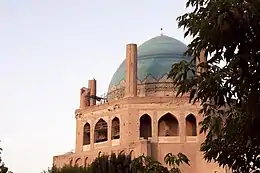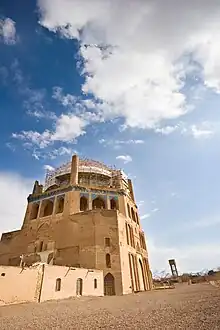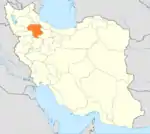Dome of Soltaniyeh
The Dome of Soltaniyeh in Soltaniyeh city, Zanjan Province, Iran, traditionally so called, is a complex of ruins centering on the Mausoleum of the Mongol ruler Il-khan Öljeitü, also known as Muhammad Khodabandeh. The estimated 200 ton dome stands 49 meters (161 ft) tall from its base, and is currently undergoing extensive renovation. Other names the Dome of Soltaniyeh is known by are the Oljeitu Dome, Dome of Sultaniyya, the Tomb of Oljeitu and Gonbad-e-sultaniyeh.
| UNESCO World Heritage Site | |
|---|---|
 | |
| Location | Soltaniyeh, Zanjan Province, Iran |
| Part of | Soltaniyeh |
| Criteria | Cultural: (ii), (iii), (iv) |
| Reference | 1188-001 |
| Inscription | 2005 (29th Session) |
| Area | 14.8 ha (37 acres) |
| Coordinates | 36°26′2.3″N 48°47′45.7″E |
 Location of Dome of Soltaniyeh in Iran | |
The main building, erected between 1302 and 1312 AD, may have the oldest double-shell dome in Iran,[1] an idea about the construction put forth by scholar Marcel-Auguste Dieulafoy. It is one of the largest brick domes in the world, just at the theoretical engineering limit for a brick dome and the third largest dome in the world after the domes of Florence Cathedral and Hagia Sophia. Much of its exterior decoration has been lost, but the interior retains superb mosaics, faience, and murals. The Dome of Soltaniyeh paved the way for more daring Iranian-style cupola constructions in the Persianate world, such as the Mausoleum of Khoja Ahmed Yasavi and the Taj Mahal. Its importance in the Islamic world may be compared to that of Brunelleschi's cupola for Christian architecture.[2]
History and patronage
The Mongol invasion of the Islamic world began with the conquest of eastern Iran in 1221, and ultimately ended the period of Abbasid rule (750-1258). The Mongols conquered most of West Asia, and a branch of the dynasty known as the Ilkhanids (1256-1353) concentrated most of their power in Iran.[3] While this conquest initially came as a devastation, the Ilkhanid period also saw major developments in art and architecture. By the architectural masterpiece that is the Dome of Soltaniyeh, the Ilkhanids proved to be capable as builders.
The Mongol presence in Iran was marked by a shift away from traditional cities dependent on an agricultural hinterland to ones with an emphasis on access to pasture.[1] An example of this new type of Mongol city was the city of Sultaniyya in northwestern Iran. Arghun, the Ilkhanid ruler of Iran at the time, established Sultaniyya as his summer capital. His son, Muhammad Oljeitu Khudabanda, furthered the city’s development and transformed it into the capital of the empire. After Oljeitu’s death, the city began a steady decline. Today, only two buildings remain that which show evidence signs of Sultaniyya’s its former wealth and importance: the octagonal tomb of the Dome of Soltaniyeh and an adjacent khanaqah, a building designed specifically for Sufi gatherings as a spiritual retreat. The quality of the preserved tomb attests to the richness of its patronage by the Sultan Oljeitu.[4]
The large domed tomb chamber of Oljeitu was meant to rival the colossal tomb built by the Seljuq Sultan Sanjar at Merv in 1157. The tomb of Oljeitu has an octagonal plan, like the Tomb of Ahmed Sanjar, with both complexes being sponsored by the Ilkhanid court and were considered some of the most prestigious buildings at the time.[5]
The Global Heritage site of Gonbad-e-sultaniyeh has been recognised as a UNESCO World Heritage Site since 2005. It followed the specific historic UNESCO criteria landscape of four characteristics: ancient and historical monuments, farms, urban landscapes, and the Historical Grass of Soltaniyeh.[6]
Architecture and interior design
The Dome of Solteniyeh was one of the largest religious endowments of the 14th century,[7] and was utilized for multiple functions, such as Quran reading, praying, teaching, housing, and medical purposes. The main building is approximately 125 feet across and is crowned by a dome with an average diameter of 80 feet. The tomb is highly visible, due to its unique incorporation of eight minarets enclosing the dome above the gallery. More specifically, Oljeitu’s complex consists of four iwans connected by arcades with muqarnas surrounding the perimeter of a courtyard. The tomb itself stands behind the southern iwan. Furthermore, the iwans were all plastered and painted, and the courtyard was paved with white marble.
The construction of the double-shelled dome employed an interlocking arched herringbone network. The Dome of Soltaniyeh was one of the first to use this pattern in Iran, and is unique in choosing brick for its material as previous similar architectural structures often utilized wood.[2]
As for the interior of the tomb, it is decorated in tile and plaster. The insides of the iwans’ walls possess white inscriptions that stand out against the blue background. The underside of the iwans are stuccoed with bands of ornament, that were later painted. A significant inscription--outlined with ogival forms sculpted over cloth--circles the entire dome. The galleries have low, wooden or marble railings. The windows are fitted with bronze screens, along with bronze knobs and balls set with gold and silver.[8] Some elements from these window grilles were inscribed with their patron’s name or with detailed scenes, such as depictions of a horseman or of falconry.
Following Islamic convention, Oljeitu’s tomb was placed in a garden, known in the Quran as a rawda. This word was also added to the railing of the Prophet Muhammad’s tomb in Medina.[9] Because of this, rawda became the label for funerary structures in Iran. Thus, Oljeitu’s tomb was referred to as a rawda. Additionally, Oljeitu ensured that water could be successfully stored and utilized in the complex, through the use of qanats and wells. A qanat is a downward sloping channel intended to transport water. Due to this, the flora and fauna surrounding the tomb were able to survive for a long time; specifically, “the gardens around the tomb complex were still being maintained in the seventeenth century.” [9]
A 16th c. illustration made by Matrakçı Nasuh reveals that the face of the complex was split into two stories and was “flanked by minarets and surmounted by five domes.” [10] According to a later drawing of the tomb by Flandin and Coste, one can see possible evidence of a cap wall projecting from the northeast corner.[11] The presence of a cap wall guarantees that there were arcades attached to the tomb. Additionally, once the site was excavated, potential proof of a limestone court encompassing the east, north, and west of the tomb was found.
Influence on other monuments
Because Oljeitu’s tomb was one of the most significant works of its time, it became an inspiration for many other complexes, both within and outside of Ilkhanid culture. Distinct features of the complex were later found on many other monuments, such as placement of paired minarets above a portal. This trend began in the Seljuq period, then became a normal inclusion in Ilkhanid buildings.[12]
The Tomb of Oljeitu, like other Ilkhanid tombs, was integrated into a great complex--which no longer remains. These complexes were the “precursors of the type of large, planned funerary complexes, known as kulliye, that (were) built by the Ottomans at Bursa and elsewhere beginning in the second half of the fourteenth century.” [13]
Another trend derived from Oljeitu’s tomb is the style of five domes placed above the portal. The Blue Mosque built by Saliha Khanum in Tabriz was inspired by this design; its portal and projecting sanctuary were very similar to Oljeitu’s complex. This famous tomb of Oljeitu remained an inspiration for several imperial Mongolian tombs, even the Taj Mahal.[13]
Dome of Soltaniyeh in Relation to the Santa Maria Del Fiore
The Dome of Soltaniyeh features many architectural similarities to Brunelisschi’s dome for the Santa Maria Del Fiore, and some architectural historians like Piero Sanpaolesi have speculated the buildings may have influenced each other despite their great distance apart.
There are several architectural similarities between the two domes. Structurally, both domes feature an arched network of herringbone bricks, called in Italian “spina -di -pesce”.[2] The Dome of Soltaniyeh's high sphero-conical dome on an octagonal base exhibits is the same structure as the Santa Maria Del Fiore, both with eight ribs supporting each structure.[14] However, the Dome of Soltaniyeh remains unique in the way that its arches and ribs structurally support the dome.
Finally both domes, feature a double-shelled structure. The Dome of Soltaniyeh was the first example of this structure in Iran, and several scholars hypothesize that it is possible for the construction system of Soltaniyeh to have been disseminated from Iran to Brunelleschi in Italy, in the time span of almost a century.[15][14]
Many academics argue that because of these similarities, and many more, that the Dome of Soltaniyeh influenced the Santa Maria Del Fiore, which was constructed 100 years later. However, it is possible that Bruneleschi and his engineers may have independently come up with the same solutions to similar architectural challenges that both domes faced.[14]
Gallery
 Village of Soltaniyeh and dome in 1969
Village of Soltaniyeh and dome in 1969
 Major reconstruction inside
Major reconstruction inside.JPG.webp) 16th century map of Soltaniyeh city
16th century map of Soltaniyeh city.JPG.webp) 16th century map of Soltaniyeh city
16th century map of Soltaniyeh city interior view
interior view Soltanieh Dom fall 2014
Soltanieh Dom fall 2014 Dome of Soltaniyeh in winter 2010
Dome of Soltaniyeh in winter 2010 Dome of Soltaniyeh in winter 2010
Dome of Soltaniyeh in winter 2010
See also
References
- Blair, Sheila S., The Mongol Capital of Sultaniyya, “The Imperial”. Iran, Vol. 24 (1986). Taylor & Francis, Ltd. pp. 139
- Ali Irani, "Structural Assessment and Historical Review of the Dome at Soltaniyeh" 2015. http://sultaniyya.org/wp-content/uploads/2015/05/Soltaniyeh_FinalPaper.pdf
- Yalman, Suzan. “The Art of the Ilkhanid Period (1256-1353).” In Heilbrunn Timeline of Art History. New York: The Metropolitan Museum of Art, October 2001.
- Blair (1986), p. 142
- Komaroff, Linda & Carboni, Stefano. The legacy of Genghis Khan: Courtly Art and Culture in Western Asia, 1256-1353. Metropolitan Museum of Art, 2001. p. 123
- Sustainable building for a cleaner environment : selected papers from the World Renewable Energy Network's Med Green Forum 2017. Ali Sayigh, World Renewable Energy Network's Med Green Forum. Cham, Switzerland. 2019. ISBN 978-3-319-94595-8. OCLC 1044756877.
{{cite book}}: CS1 maint: location missing publisher (link) CS1 maint: others (link) - Blair (1986), p. 144
- Eleanor G. Sims. “The Iconography’ of the Internal Decoration in the Mausoleum of Uljaytu at Sultaniyya.” In Content and Context of Visual Arts in the Islamic World, edited by Priscilla P. Soucek, pp. 139-75. Monographs on the Fine Arts, 44. University Park, Pa., and London: Pennsylvania State University Press, 1988.
- Blair (1986), p. 145
- Blair (1986), p. 144
- Blair (1986), p. 141
- D. Wilber, The Architecture of Islamic Iran: the Ilkhanid Period (Princeton, 1955), no. 27
- Komaroff, Linda & Carboni, Stefano. The legacy of Genghis Khan: Courtly Art and Culture in Western Asia, 1256-1353. Metropolitan Museum of Art, 2001.
- Adapted from UNESCO Institute for Statistics (UIS), THE DOME OF SOLTANIYEH THE PASTURE WHICH BECAME THE CAPITAL CITY OF AN EMPIRE, https://whc.unesco.org/uploads/nominations/1188.pdf , 2005
- Necipoğlu, Gülru (2017). "Architectural Dialogues Across the Eastern Mediterranean: Monumental Domed Sanctuaries in the Ottoman Empire and Renaissance Italy", in Alina Payne, Renaissance and Baroque Architecture. Hoboken, NJ: John Wiley & Sons. pp. 594–623. ISBN 9781444338515.
